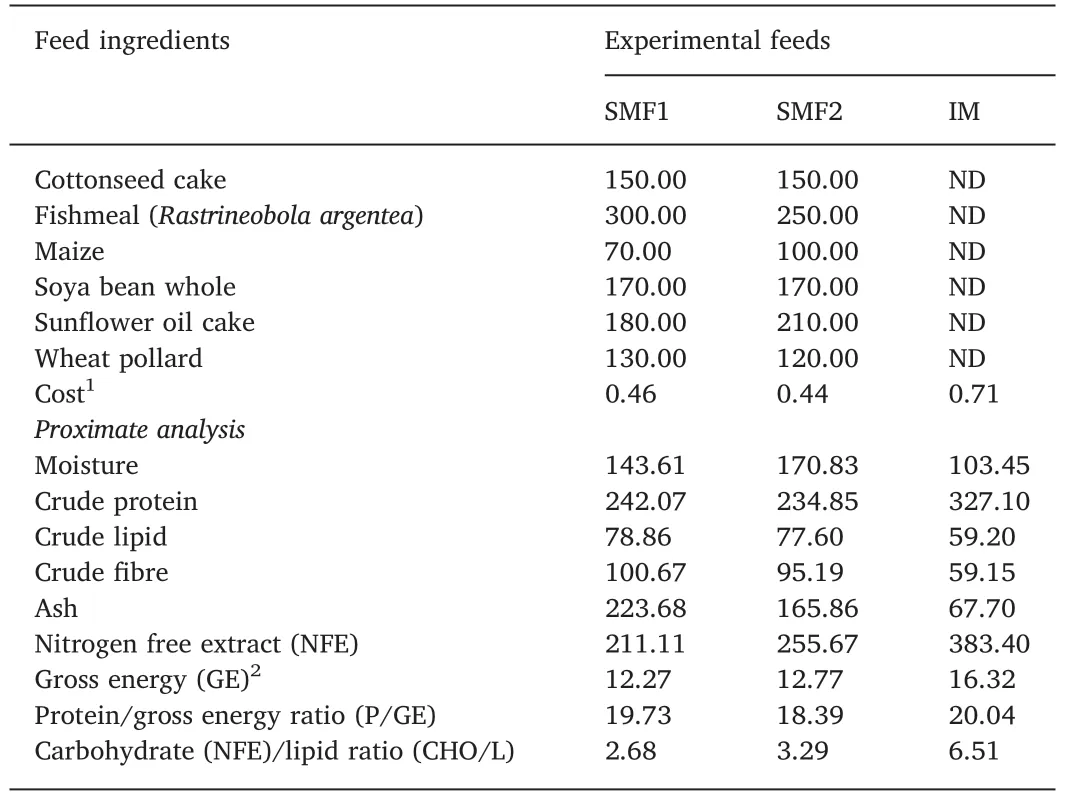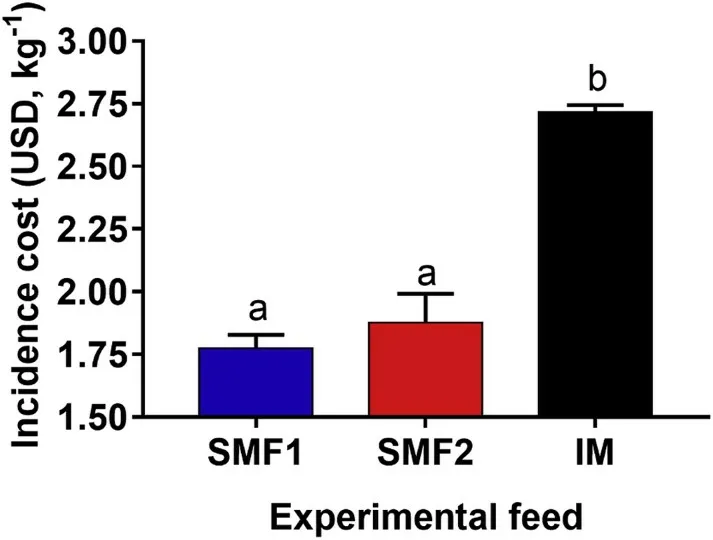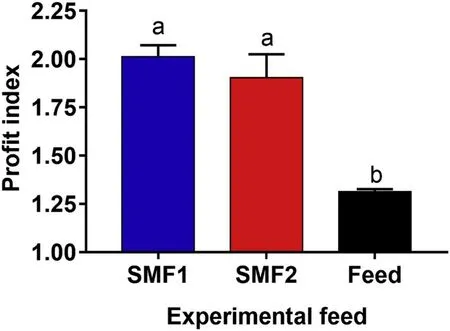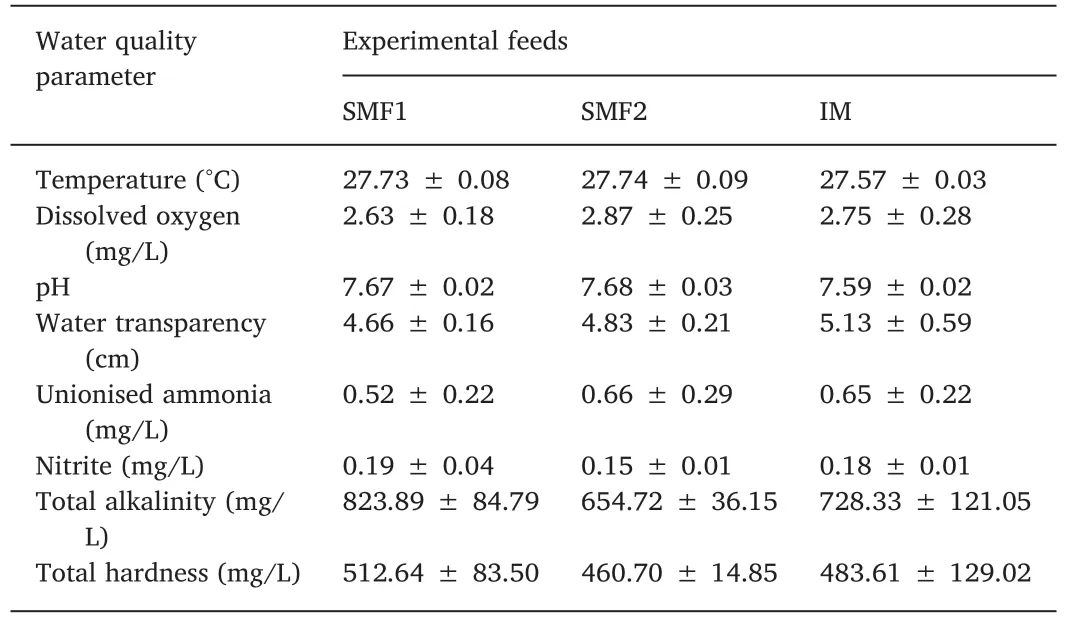The effects of on-farm produced feeds on growth,survival,yield and feed cost of juvenile African sharptooth catfish(Clarias gariepinus)
2020-02-28SamwelMcheleLimbu
Samwel Mchele Limbu
a Department of Aquatic Sciences and Fisheries Technology,University of Dar es Salaam,P.O.Box 35064,Dar es Salaam,Tanzania
b Laboratory of Aquaculture Nutrition and Environmental Health,Department of Biology,School of Life Sciences,Shanghai,200241,China
Keywords:
ABSTRACT
1.Introduction
Development of cost-effective and nutritionally adequate formulated feeds for semi-intensive culture hold fundamental sustainable prospect for the culture of African sharptooth catfish(Clarias gariepinus)in developing countries.The African sharptooth catfish is one of the most important cultured fish species in developing countries such as Nigeria(Abalaka,Fatihu,Ibrahim,& Ambali,2015;Adewolu & Adoti,2010;Adeyemo,Obande,& Solomon,2014;Mustapha,Akinware,Faseyi,& Alade,2014;Nwanna,2002;Oso,Edward,Ogunleye,&Majolagbe,2013),Tanzania(Limbu,Shoko,Lamtane,Kishe-Machumu,Joram,Mbonde,Mgana & Mgaya,2017;Limbu,Shoko,Lamtane,Shirima,Kishe-Machumu,Mgana & Mgaya,2015;Shoko,Limbu,&Mgaya,2016a;Shoko,Limbu,Mrosso,Mkenda,& Mgaya,2016b),Kenya(Charo-Karisa,Opiyo,Munguti,Marijani,& Nzayisenga,2013;Nyina-Wamwiza,Milla,Pierrard,Rurangwa,Mandiki,Van Look &Kestemont,2012;Nyina-Wamwiza,Wathelet,Richir,Rollin,&Kestemont,2010),Uganda(Isyiagi,Veverica,Asiimwe,& Daniels,2009,p.222),Cameroon(Yong-Sulem,Tomedi,Mounchili,Tekeng,&Brummett,2006)and Democratic Republic of Congo(de Graaf &Janssen,1996,p.73).Its culture in these countries occurs mainly in semi-intensive earthen ponds,which are mostly farmer owned,operated and managed(Charo-Karisa et al.,2013),while intensive tank culture is becoming more popular in peri-urban areas in Nigeria(Hecht,2013).The farming of African sharptooth catfish lacks suitable diets designed for semi-intensive pond production.The industrially manufactured(IM)feeds are often too expensive for rural fish farmers who mostly live on less than a dollar daily(Charo-Karisa et al.,2013).Since feeds account for more than half of the operating cost,managing feed cost is critical to the profitability and sustainability of African sharptooth catfish production.
The African sharptooth catfish farmers in developing countries use various feeding and culture approaches in order to curb the lack of semi-intensive feeds(SMF).Some farmers who practise its monoculture such as those from Kenya,use a few available expensive IM feeds(Charo-Karisa et al.,2013),while others such as those from Tanzania,limit its farming to polyculture with Nile tilapia,Oreochromis niloticus(Limbu et al.,2015;Shoko et al.,2016b).Farmers practising monoculture of African sharptooth catfish feed occasionally their fish in an attempt to reduce feed cost,resulting in increased cannibalism by the fast growing fish on the slow growing(de Graaf&Janssen,1996,p.73;Hecht & Appelbaum,1988;Mukai,Sanudin,Firdaus,& Saad,2013;Naumowicz,Pajdak,Terech-Majewska,& Szarek,2017).This feeding approach causes reduced total fish growth and survival rates,lowers production and consequently discourage farmers from engaging in aquaculture production(Shoko et al.,2016b).
An appropriate approach to reduce feed cost for African sharptooth catfish farmers is to formulate and produce cost-effective and nutritionally adequate feeds at farms by using locally available ingredients.On-farm produced fish feeds can boost productivity and reduce feed cost in aquaculture in developing countries(FAO,2016,p.200;Gabriel,Akinrotimi,Bekibele,Onunkwo,& Anyanwu,2007;Hecht,2013).In practice,semi-intensive fish farming in earthen ponds requires feeds that are designed to supplement available nutrients obtained from natural food organisms,such as phytoplankton rather than providing all the necessary nutrients such as high protein content.The phytoplankton(Kang'ombe,Brown,& Halfyard,2006)and other natural food organisms(Abou,Aina,Fiogbé,& Micha,2013)have high nutritional value,that generally account for a large share of total fish growth performance and survival in fish cultured in semi-intensive earthen ponds(Limbu,Shoko,Lamtane,Kishe-Machumu,Joram,Mbonde,Mgana & Mgaya,2016).This approach has shown success in the culture of Nile tilapia(Limbu et al.,2016;Liti,Cherop,Munguti,&Chhorn,2005).The African sharptooth catfish is able to survive and grow when fed diets that include locally available plant ingredients such as sunflower oil cake,bean meal and groundnut oil cake(Nyina-Wamwiza et al.,2010),walnut(Tetracarpidium conophorum)leaf and onion(Allium cepa)bulb residues(Bello,Emikpe,& Olaifa,2012),Moringa oleiferaleaves extract,unripe plantain powder,soybean meal and wheat offal(Ekanem,Eteng,Nwosu,& Eyo,2012),maize meal,crude sunflower oil cake,bean meal and ground nut oil cake(Nyina-Wamwiza et al.,2012),winged bean(Psophocarpus tetragonolobus)seed meal(Fagbenro,1999)and sesame(Sesamum indicum)seed meal(Jimoh,Fagbenro,&Adeparusi,2014)based on its omnivorous feeding habit(Dadebo,Aemro,& Tekle-Giorgis,2014).Thus,it is feasible that,locally available ingredients formulated and blended correctly at farm level may reduce feed cost in developing countries for sustainable aquaculture production.
The use raw and/or semi-processed agro-industrial by-products such as freshwater shrimp(Caridina nilotica),rice bran(Oryza sativa)and wheat bran(Triticum aestivum)(Charo-Karisa et al.,2013)is becoming a common practice among African catfish farmers in some developing countries.However,limited work has been conducted to compare the cost-effectiveness of on-farm produced and IM feeds to assist African catfish farmers reduce feed cost while providing optimum growth performance,survival rate,nutrient utilization and yield(Charo-Karisa et al.,2013;Opiyo,Githukia,Munguti,& Charo-Karisa,2014).The present study formulated and produced cost-effective diets by using locally available ingredients for semi-intensive production of African sharptooth catfish.The quality of the formulated diets was tested by addressing the fish growth,survival,nutrient utilization,body composition and yield.
2.Materials and methods
2.1.Ethical statement
The present study was not evaluated by an Animal Ethics Committee because such a committee did not exist in Uganda during the study period.However,fish sampling techniques followed international guidelines for ethical use of animals as described by Grigorakis(2010).The fish sampled for hepatosomatic index(HSI)and apparent netprotein utilization(ANPU)evaluation were sedated by immersing them in an ice-slurry(4℃-2℃)to avoid causing stress and pain(Sneddon,2012).

Table 1 Formulation and proximate composition of the experimental feeds(g/kg dry weight),cost(USD/kg),gross energy(kJ/g),protein to gross energy ratio(P/GE)(mg/kJ)and carbohydrate(NFE)/lipid ratio(CHO/L)used to feed African sharptooth catfish(Clarias gariepinus)during the experiment.
2.2.Formulation and production of the experimental feeds
Two sinking pelleted feeds designated as semi-intensive feed 1(SMF1)and semi-intensive feed 2(SMF2)were formulated with the aid of a computer programme(Winfeed 2.8)using available ingredients(Table 1).These diets,together with an industrially manufactured(IM)floating diet(as control),which was purchased from a local feed manufacturer in Uganda,were used for feeding African catfish reared in earthen ponds for eight weeks.Dry ingredients for formulation of onfarm feeds were purchased from local suppliers.During production of on-farm feeds,maize and soybeans were processed in order to reduce anti-nutritional factors and improve nutrient bioavailability of fish as described elsewhere(Womeni,Tiencheu,Linder,Nabayo,Tenyang,Mbiapo,Villeneuve,Fanni & Parmentier,2012)by soaking them in freshwater overnight and 8 h,respectively followed by boiling for half to 1 h and then solar dried about a day.Afterwards,they were drycooked(roasted)and finally solar-dried for about a day.Apart from grinding,the other ingredients used in the production of the on-farm diets were not subjected to any processing.
Dried ingredients were milled into fine particles using a grinder machine(hammer mill)with a screen size of 0.8 mm,weighed and mixed separately in the required proportions according to formulations.The resulting mixture was blended with sufficient hot boiling water(100℃)to form a dough.Pellets were produced by extruding this dough through a meat grinder/mincer with a die size of 4 mm and subsequent solar-dried at about 30℃ for 36 h until complete dryness.The diets were then sealed into airtight black containers and stored in a refrigerator until needed for use.
A 100-g sample of each dried diet was analysed at Stirling University laboratory for moisture,protein,lipid,fibre and ash by using standard methods(AOAC,1995,p.1094).Moisture was determined by oven drying at 105℃ for 24 h.Crude protein(N×6.25)was determined by the Kjeldahl method after digestion with concentrated H2SO4.Ash content was determined by incineration in a muffle furnace at 600℃ for 16 h.Crude lipid was determined by the Soxhlet method using petroleum ether and crude fibre was determined by digestion with 1.25%NaOH and 1.25%H2SO4.Gross energy was calculated using the conversion factors for protein,lipid and carbohydrate given by Tacon(1990,p.454).Nitrogen free extract(NFE)was calculated by subtracting the sum of moisture,protein,lipid,fibre and ash contents from 100.The protein to energy ratio(P/GE)and carbohydrate(NFE)to lipid ratio(CHO/L)were also calculated.
2.3.Feeding of fish during the experiment
The on-farm feeding experiment was conducted in a set of nine identical static earthen ponds(5×4 m2)with mean depth of 0.5 m.The supplied water to the ponds was from a water well.Triplicate ponds were randomly stocked with 200 fish per pond(14.95±0.24 g)following two weeks of acclimatization.The fish were fed the three diets a feeding rate of 5%average body weight twice daily(09:00 to 10:00 and 16:00 to 17:00)for eight weeks.The on-farm sinking diets were fed by using two rectangular wooden feeding trays(0.6×0.5×0.05 m3)fitted with a one-mm nylon net material at their bottoms submerged at diagonal opposite corners of each pond.The floating IM diet was handfed by dispersing at the water surface of each pond.
2.4.Fish sampling for determination of growth performance,survival,feed efficiency and yield
Twenty fish were randomly sampled from each pond by using a seine net for individual weight(g)and length(cm)measurements after two weeks intervals during the eight weeks and the respective diet weights in each pond were adjusted accordingly.Total weight and length of individual fish were measured by using a sensitive measuring balance and a measuring board,respectively.The fish were returned immediately into their respective ponds after weight and length measurements.Weight data of fish were used to determine specific growth rate(SGR)using the formula given by De Silva and Anderson(1995,p.320).At the end of the experiment,water in all ponds was emptied and fish were counted and weighed for determination of final weight.The survival was calculated as the percentage-ratio of the number of the fish at the end to those at the start of the experiment.The total weight of stocked and harvested fish were used for estimation of annual net fish yield(NFY)as reported previously by Limbu et al.(2015).The amount of feed fed and protein levels in the diets were used to calculate feed conversion ratio(FCR)and protein efficiency ratio(PER)using the formulae given by De Silva and Anderson(1995,p.320).An initial sample of six fish per treatment was sacrificed at the start and the end of the experiment,wet weight measured,dissected and their livers weighed for estimation of HSI using a formula given by De Silva and Anderson(1995,p.320).
2.5.Body composition analyses of fish samples
After removal of livers for HSI measurement,fish were dried in an oven at 105℃ until constant weight.The dry fish were analysed for moisture,protein,lipid,ash and NFE according to the standard methods(AOAC,1995,p.1094).Fish protein gain values obtained were used to calculate ANPU using the formula given by De Silva and Anderson(1995,p.320).
2.6.Economic analysis
A partial enterprise budget was used to assess the cost-effectiveness of feeds used in the present study.The cost of feed was calculated using market prices,taking into consideration the processing costs and the transport fare.During calculation,costs such as pond construction,fingerlings cost and labor cost were assumed to be constant.Incidence cost and profit index were estimated according to El-Dakar,Shalaby,and Saoud(2007).
2.7.Water quality monitoring
Water temperature,dissolved oxygen and pH in ponds water were monitored twice-daily(0900 h and 1700)using a DO meter(VWR 2000;Atlanta,GA,USA)and a pH meter(Hanna Replacement pH electrode HI 98128,Toronto,Canada),respectively.Unionised ammonia,nitrite,hardness and alkalinity were measured once a week using a Palintest kit(Photometer 7100,England,UK).
2.8.Statistical analyses
Results are presented as means±standard error(SE).Data were tested for normality and homogeneity of variances by using Shapiro-Wilk and Levene's tests,respectively.Not normally distributed data were analysed by using Kruskal-Wallis(H)followed by Mann-Whitney(U)test.One-way analysis of variance(ANOVA)was used to analyze normally distributed data followed by Tukey's post hoc test.Pearson's correlation was used to assess the relationship among the measured parameters.Significant levels were judged at ap≤0.05 for all other tests except Pearson's correlation,which was judged at significant levels ofp≤0.01 andp≤0.05.All statistical analyses were performed by using SPSS for windows version 20(IBM,Armonk,NY,USA).
3.Results
3.1.Growth performance and survival rate
After 42 days of feeding,the weight increment of fish fed the SMF2 diet was significantly(p<0.05)lower than fish fed SMF1 and IM diets,while fish fed SMF1 and IM diets revealed statistically comparable growth increments(Fig.1).The final fish weight after 56 days of feeding,also differed significantly among the diets.The fish fed the SMF2 diet had significantly(p<0.05)lower final weight than those fed on SMF1 and IM diets.No significant differences in final weights were revealed between fish fed SMF1 and IM diets(p>0.05).Feeding fish using the on-farm produced and IM diets affected significantly SGR(Table 2).The fish fed the SMF2 diet revealed significantly(p<0.05)lower SGR than those fed SMF1 and IM diets,while no statistical difference was revealed between fish fed SMF1 and IM diets.The protein content in the feeds was significantly positively correlated with final weight(r=0.704,p=0.034)and SGR(r=0.831,p=0.006).Similarly,PER of the diets was significantly positively correlated with final weight(r=0.834,p=0.039)and SGR(r=0.927,p=0.008).Fish survival did not differ significantly among the experimental diets used(p>0.05).

Fig.1.The growth response of African catfish(Clarias gariepinus)fed on onfarm formulated and produced diets(SMF1 and SMF2)and industrially manufactured(IM)diet during the study.

Table 2 Growth performance parameters,feed utilization,hepatosomatic index and proximate composition of African sharptooth catfish fed the on-farm produced feeds(MSF1 and SMF2 feeds)and industrially manufactured feed(IM).
3.2.Nutrient utilization efficiencies
The FCR and PER of the fish fed the on-farm produced and IM diets were not significantly affected(Table 2).However,ANPU was significantly(p<0.05)affected by the experimental diets used.The fish fed the IM diet had significantly(p<0.05)lower ANPU than those fed on SMF1 and SMF2 diets(Table 2).The ANPU of fish fed on SMF1 and SMF2 diets was statistically comparable.The ANPU values were significantly negatively correlated with CHO/L ratio(r=-0.999,p<0.001).
3.3.Hepatosomatic index(HSI)
The different diets significantly(p<0.05)affected HSI of fish(Table 2).The fish fed the IM diet had larger and yellow coloured livers compared to smaller and reddish/brown livers of fish fed using the onfarm formulated and produced diets(Fig.2).The fish fed the IM diet had significantly(p<0.05)higher HSI compared to fish fed SMF1 and SMF2 diets.However,the fish fed SMF1 and SMF2 diets had statistically(p>0.05)similar HSI.The HSI was significantly positively correlated with NFE of the diets(r=0.943,p=0.005).
3.4.Proximate composition of fish
The experimental diets significantly(p<0.05)affected the ash content of the fish(Table 3)and the IM diet had significantly(p<0.05)lower ash content than the SMF1 diet.Feeding fish the SMF2 diet revealed no statistical difference in ash content than SMF1 and IM diets.The experimental diets did not significantly(p>0.05)affect moisture,protein,lipid and NFE contents of the fish.
3.5.Net fish annual yield

Fig.2.The representative livers from African sharptooth catfish(Clarias gariepinus)fed on on-farm formulated and produced diets(SMF1 and SMF2)and industrially manufactured(IM)diet during the study.

Table 3 The proximate composition of African sharptooth catfish(Clarias gariepinus)fed the on-farm produced feeds(SMF1 and SMF2 feeds)and industrially manufactured feed(IM).

Fig.3.The mean annual net fish yield(tons ha-1 year-1)of African sharptooth catfish(Clarias gariepinus)fed on on-farm formulated and produced diets(SMF1 and SMF2)and industrially manufactured(IM)diet during the study.Different letters above bars indicate significant difference(p<0.05).
Feeding fish the on-farm produced and IM diets significantly(p<0.05)affected the NFY(Fig.3).The fish fed the SMF2 diet had significantly(p<0.05)lower NFY than those fed SMF1 and IM diets,while fish fed the SMF1 and IM diets revealed no statistical difference(p>0.05).The NFY was significantly positively correlated with both final weight and SGR(r=0.995,p<0.001).
3.6.Economic analysis

Fig.4.Incidence cost of African sharptooth catfish(Clarias gariepinus)fed on on-farm formulated and produced diets(SMF1 and SMF2)and industrially manufactured diet(IM)during the study.Different letters above bars indicate significant difference(p<0.05).

Fig.5.Profit index of African sharptooth catfish(Clarias gariepinus)fed on onfarm formulated and produced diets(SMF1 and SMF2)and industrially manufactured(IM)diet during the study.Different letters above bars indicate significant difference(p<0.05).
The fish fed the IM diet had higher cost per kg(0.71 USD/kg)than SMF1(0.46 USD/kg)and SMF2(0.44 USD/kg)diets,representing 36%and 39%lower cost for SMF1 and SMF2 diets,respectively than IM diet(Fig.4).The incidence cost of fish was significantly(p<0.05)affected by the three diets,with the IM diet depicting the highest incidence cost.However,the incidence cost between fish fed SMF1 and SMF2 diets revealed no statistical difference(p>0.05).Contrary,the profit index of fish fed the IM diet was the lowest of all the diets(p<0.05;Fig.5),while the on-farm formulated and produced diets revealed no statistical difference(p>0.05).The incidence cost of fish fed the IM feed was 35% higher than those fed using the on-farm diets,whereas the profit index of IM diet was lower by 31% compared to the on-farm diets.
3.7.Water quality parameters
No water quality parameter varied significantly(p>0.05)among the experimental diets used(Table 4).
4.Discussion
The sustainability of African sharptooth catfish culture in developing countries depends on low cost and good quality feeds,which provide optimum growth,survival,feed efficiency and yield.The SGR revealed in the present study is similar to that reported by Ekanem et al.(2012)for African catfish fed plant and animal-based ingredients.The results obtained on the higher growth rate are attributed to relatively higher protein content of the on-farm produced(SMF1)and the IM feeds.Increase in protein is known to promote faster growth rate of African catfish in aquaculture(Morenike&Akinola,2010).Indeed,the growth rate in the present study was proportional to the amount of protein contained in the feeds.Thus,the lowest growth performancewas revealed by feeding fish with lowest protein content(SMF2 diet).The protein content in the formulated feeds were lower than the optimum level(about 400 g/kg)as the present study aimed to formulate semi-intensive feeds.For these culture systems,there is no need to produce feeds with optimum protein content,because the fish can obtain additional nutrients from phytoplankton and other natural food organisms present in the culture water(Kang'ombe et al.,2006;Abou et al.,2013).To scrutinize more on growth performance,the digestibility of the diets and digestive enzymes activities in fish should be assessed in future studies using on-farm formulated diets.These results indicate that,semi-intensive feeds if properly formulated and produced at farm level with appropriate nutrients such as protein as the SMF1 diet can afford similar growth performance to IM feeds.

Table 4 Water quality parameters measured in the ponds used to culture African sharptooth catfish(Clarias gariepinus)during the study.
The present study indicated higher ANPU in African sharptooth catfish fed on on-farm produced diets than the IM diet.The higher values of ANPU in African catfish fed on on-farm produced feeds is related to lower CHO/L ratio.The optimum CHO/L ratio for African catfish ranges from 1.7 to 3.4(Ali & Jauncey,2004).In the present study,the CHO/L ratio was 2.68,3.29 and 6.51 for SMF1,SMF2 and IM diets,respectively and it was inversely proportional to the ANPU values.It has been reported that imbalance in CHO/L ratio may affect directly the nutrient retention(Erfanullah & Jafri,1998)and may depress feed utilization(Zhou,Wang,Xie,Deng,&Zhou,2016).Since the on-farm produced diets had CHO/L ratios within the optimum value(Ali & Jauncey,2004),the ANPU was higher compared to IM diet,which had unbalanced and elevated CHO/L ratio.Ultimately,the optimal CHO/L ratios of the on-farm produced diets led to higher ANPU of the African catfish.To delineate further on nutrients utilization,future studies should explore the lipid,protein and carbohydrate metabolism.These results imply that,on-farm formulated feeds can offer better nutrient retention than IM feed when formulated appropriately and produced.
The present study indicated higher HSI for African sharptooth catfish fed on IM diet than the on-farm formulated diets,which is attributed to its higher carbohydrate content.Higher carbohydrate content in feeds has been shown to result in higher HSI in African catfish(Ali &Jauncey,2004;Enyidi,Pirhonen,&Vielma,2014;Luo&Xie,2010).In fact,the carbohydrate level significantly correlated with HSI in the present study,suggesting that,the higher carbohydrate induced deposition of glycogen into the liver(Hu,Ferrell,Lim,& Davis,2012;Zhou et al.,2016),which caused the higher HSI.Enlarged liver is undesirable in cultured fish because it can impair liver functions.The yellow livers in captive African sharptooth catfish have been ascribed to nutrients deficiency in feeds(Huchzermeyer,Osthoff,Hugo,&Govender,2013).This observation accords with the lower ash content of African sharptooth catfish fed the IM diet.Ash content represents the total amount of mineral compounds and is an important indicator of fish quality.It is been shown that,ash content correlates with calcium and magnesium in the whole body of bony fish(Chaimongkol &Boonyaratpalin,2001).The observed yellow livers in the fish fed the IM diet may be caused by liver cirrhosis due to deficiencies in magnesium(Lim & Jacob,1972)and calcium(Wilson,Ali,Scrimgeour,Martin,Hua,Tallis,Rychkov&Barritt,2015),an aspect which requires further studies to confirm.Furthermore,given the important functions of liver in nutritional metabolism and immunity,further information is required to assess the hepatic nutrients metabolism and immune response in fish fed on on-farm formulated diets.In general,these results suggest that,the on-farm formulated and produced feeds used in the present study were nutritionally adequate for semi-intensive production.
The present study showed that,the IM and SMF1 diets produced higher fish yield than SMF2 diet.The yields obtained in the present study are similar to values projected by Hecht(2013)under monoculture static pond conditions for African catfish fed on farm-made feeds.The higher yield of fish fed IM and SMF1 diets is due to their higher growth rate.During the present study,the growth rate of fish fed IM and SMF1 diets was significantly higher than fish fed SMF2 diet.In addition,the growth rate was significantly positively correlated with NFY and the water quality parameters did not vary among the diets,similar to the results of Shoko et al.(2016a).The higher growth rate of fish fed on IM and SMF1 diets led to harvest of heavier fish resulting into higher yield than those fed on SMF2 diet.These results suggest that,on-farm feeds when formulated and produced with appropriate quality can improve fish production similar to IM feeds.
The higher incidence cost and lower profit index obtained in fish fed the IM diets are related to its cost.The cost of IM diet was almost twice than that of the on-farm formulated diets.Incidence cost reflects the monetary value of feed required to produce a kilogram of fish,where lower value indicates more profitability(Abu,Sanni,Erondu,&Akinrotimi,2010).Thus,the incidence cost and profit index were more than 30% higher and lower,respectively for the IM diet than on-farm formulated diets.This implies that,African catfish farmers can reduce feed cost by 30% when using on-farm formulated feeds than the IM feed.
Taken together,the present study indicates that on-farm produced feeds when formulated correctly and blended properly such as the SMF1 diet can provide similar growth performance,survival and yield of African sharptooth catfish as IM diet and assist farmers to reduce feed cost by more than 30%.They can offer better nutrient retention and fish liver health than IM diet.
杂志排行
Aquaculture and Fisheries的其它文章
- Probiotics in shellfish aquaculture
- Identification and modulation of expression of a TNF receptor superfamily member 25 homologue in grass carp(Ctenopharyngodon idella)
- Identification and histopathological and pathogenicity analysis of Aeromonas salmonicida salmonicida from goldfish(Carassius auratus)in North China
- Comparison of juvenile growth of wild and hatchery-raised olive flounders Paralichthys olivaceus as examined by otolith microstructure
- Biofloc technology(BFT):Adjusting the levels of digestible protein and digestible energy in diets of Nile tilapia juveniles raised in brackish water
